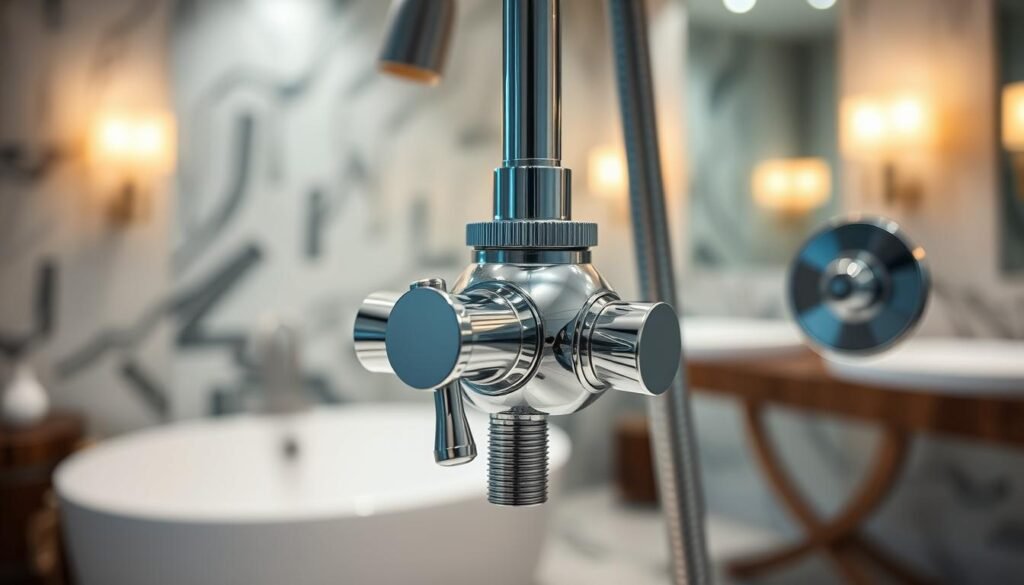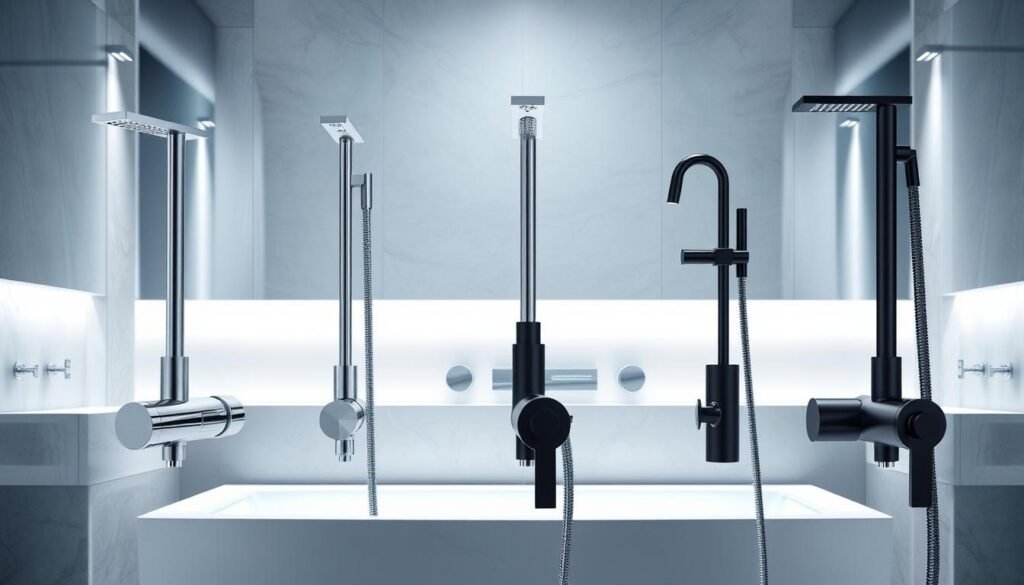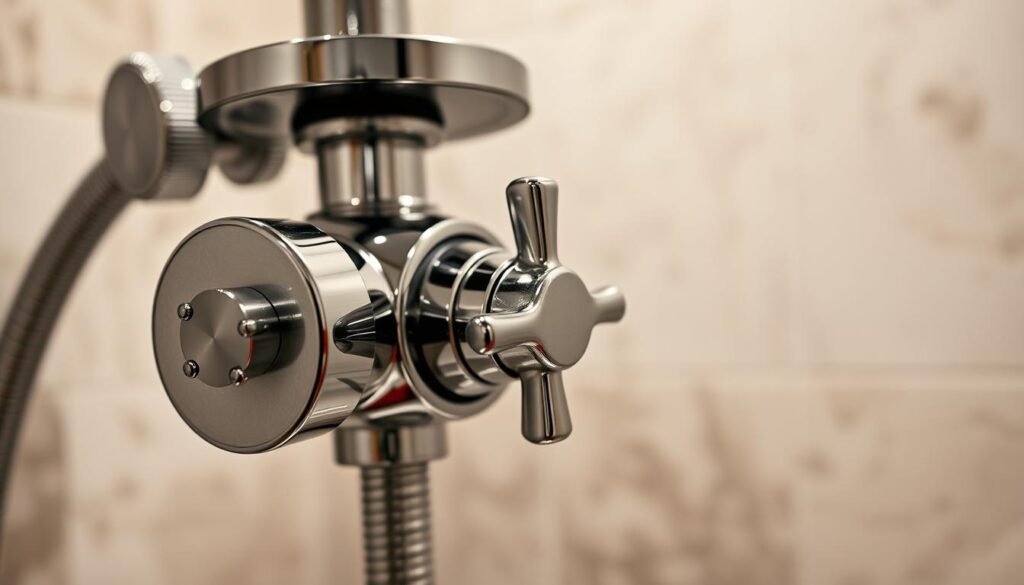Your shower valve is key to a great shower experience. It manages water pressure, temperature, and flow to your showerhead and accessories.
The right valve ensures a comfortable, safe, and consistent shower. Let’s explore different valve types, features, and top brands.
We’ll also cover how to identify and maintain your current shower valve.
Table of Contents
ToggleKey Takeaways
- Pressure-balancing valves (PB) are the most common type, ideal for 1-2 showerheads, offering automatic control of water pressure and temperature.
- Thermostatic valves (TS) provide precise temperature control, ideal for large showers with multiple fixtures, but are more expensive.
- Shower mixing valves are an outdated option prone to scalding issues, often found in older homes.
- Shower diverter valves are essential for tub-shower combos, with variations like tee, 2-valve, and 3-valve diverters.
- Top shower valve brands include Kohler, Moen, and Delta, known for their quality, features, and warranties.
What is a Shower Valve?
A shower valve is a crucial part hidden in your bathroom wall. It controls water flow, pressure, and temperature for your shower. This vital component ensures a safe and consistent showering experience.
The valve’s cartridge connects to external trim handles. This allows you to adjust water flow and temperature to your liking.
Understanding the Inner Workings of a Shower Valve
The shower valve’s core mechanism balances incoming hot and cold water supplies. This keeps water temperature stable, even when water pressure or temperature fluctuates in your home’s plumbing.
Internal components work together to deliver a reliable shower. They prevent sudden temperature spikes that could be dangerous.
The Role of Shower Valves in Regulating Water Flow and Temperature
Shower valves are key to a seamless, enjoyable showering experience. They regulate water flow and temperature, allowing precise control over water amount and warmth.
This control helps save water and reduce energy use. It also ensures a safe, comfortable shower every time.
| Valve Type | Water Temperature Regulation | Ideal for |
|---|---|---|
| Pressure-Balancing Valves | Maintain temperature within 2-3 degrees | 1-2 showerheads or faucets |
| Thermostatic Valves | Maintain temperature within 1 degree | Large showers with multiple heads and sprays |
| Shower Mixing Valves | Prone to scalding, no longer permitted in new buildings | Outdated option |
“Properly maintaining and replacing your shower valve and cartridge can significantly extend the lifespan of your shower system and ensure a reliable, comfortable showering experience for years to come.”
Shower Faucet vs Shower Valve
Upgrading your shower? Know the difference between a shower faucet and a shower valve. The faucet includes visible parts like showerhead and handles. The valve regulates water flow and temperature behind the scenes.
These elements work together but are separate components. The valve is often sold separately from trim and accessories. Ensure compatibility for a smooth installation.
- Shower Faucet: The visible part controlling water flow and temperature, offering aesthetic appeal.
- Shower Valve: The hidden component responsible for mixing water and balancing pressure.
Consider both faucet and valve when upgrading your shower system. This ensures a functional and attractive setup. Consult a plumber to choose the right components and ensure code compliance.
https://www.youtube.com/watch?v=sr_8vF84Y2g
“Choosing the right shower valve is just as important as selecting the perfect shower faucet. The two work together to create a seamless and enjoyable showering experience.”
Understanding faucet and valve differences is key to bathroom upgrades. By considering both, you’ll create an efficient and safe shower system. Your new setup will look great and work well.
Types of Shower Valves
Choosing the right shower valve is crucial for your bathroom. Several options exist, each with unique benefits. Let’s explore these varieties to help you decide.
Pressure-Balancing Valves: The Industry Standard
Pressure-balancing valves are the most common shower valve type. They control water pressure balance between hot and cold water. These valves maintain a consistent temperature within 2-3 degrees.
They work best for showers with 1-2 showerheads or faucets. Pressure-balancing valves are usually the most budget-friendly option.
Thermostatic Valves: Precise Temperature Control
Thermostatic valves offer exact control over water temperature. You can preset your desired temperature on the valve. These valves keep water temperature within 1 degree.
They’re popular for larger showers with multiple heads and sprays. Thermostatic valves cost more but provide advanced temperature regulation.
Shower Mixing Valves: An Outdated Option
Shower mixing valves blend cold and hot water before sending it to the showerhead. These valves can cause scalding and lack proper temperature control.
New building codes no longer allow shower mixing valves. They’re less safe than pressure-balancing or thermostatic options.
Knowing these valve types helps you pick the best for your needs. You’ll enjoy a safe, comfortable shower experience.
Shower Diverter and Transfer Valves
Shower diverter valves redirect water flow in tub-shower combos. They switch between bathtub faucet and showerhead, or various shower fixtures. Three main types exist: tee diverter, 2-valve diverter, and 3-valve diverter.
Shower transfer valves distribute water to multiple shower outputs at once. They allow control of water flow to different fixtures independently. This enables a more personalized shower routine.
- Tee diverter valves: Offer a basic two-way diversion, allowing water to flow either to the bathtub or the showerhead.
- 2-valve diverter: Provides more flexibility, with the ability to direct water to the showerhead and a secondary fixture, like a body spray.
- 3-valve diverter: The most advanced option, enabling users to independently control the water flow to the bathtub, showerhead, and a third fixture, such as a hand shower.
Understanding these valves helps in making informed decisions for bathroom renovations. They ensure a seamless and personalized showering experience. Choose the right valve for your tub-shower combo setup.

“A well-designed shower diverter valve can truly transform the way you experience your daily shower routine, making it more convenient, versatile, and enjoyable.”
Concealed vs Exposed Shower Valves
Weighing the Pros and Cons of Each Installation Method
Shower valve installation offers two main choices: concealed or exposed. Each method has unique benefits and drawbacks. Your decision should match your bathroom’s needs and your preferences.
Concealed shower valves create a modern, minimalist look. They’re perfect for contemporary bathrooms. These systems save space, giving you more room to shower.
Concealed showers are easier to clean. Most pipes and fittings are hidden behind the wall. This sleek design reduces clutter and simplifies maintenance.
Exposed shower valves are simpler to install. All parts are mounted above the tiles. This method is often cheaper, making it budget-friendly.
Exposed showers are easier to repair. The components are readily accessible. This can save time and money on future maintenance.
Concealed showers require more complex installation. Wall modifications and plumbing changes are often necessary. Maintenance can be tricky due to hidden components.
Exposed showers may take up more space. They can be harder to keep clean. External parts are more prone to wear and stains.
Your choice depends on bathroom size, style, and budget. Concealed showers offer a sleek look and maximize space. Exposed showers provide varied designs and easier upkeep.
Top Shower Valve Brands
Several top brands offer high-quality shower valves for your bathroom. These manufacturers provide reliable and innovative solutions for homeowners and contractors.
Kohler, Moen, and Delta are trusted names in the shower valve industry. They engineer durable products with exceptional performance and precise water flow control.
- Hansgrohe iBox Universal Leak Preventing Valve – A universal type with 2 outlets, made of brass for durability.
- Grohe Grohsafe Pressure Balance Rough-In Valve – A pressure-balancing type with 2 outlets, also made of brass.
- Moen S3102 Smart Shower Digital Thermostatic Valve – A thermostatic type with 2 outlets, utilizing various materials for enhanced performance.
- Delta Faucet Ashlyn Single-Handle Shower Faucet – A pressure-balancing type with 1 outlet, crafted from durable brass.
- Mingor Brass Shower Arm Diverter Valve – A diverter valve to control water flow direction, constructed from brass.
Other popular brands include Brizo, American Standard, Symmons, and Central Brass. These companies offer unique features, styles, and installation options for various preferences.

When choosing a shower valve, consider water pressure, temperature control, and outlet requirements. Research these leading brands to find the perfect fit for your bathroom.
Compare features and performance to make an informed decision. This will ensure a great showering experience in your home.
Identifying Your Existing shower valve
Knowing your shower valve type is key for replacements or repairs. This knowledge helps with shower faucet identification and shower valve replacement projects. Understanding your valve’s type and brand simplifies the process.
Tips for Determining Your Current Valve Type and Brand
Here are steps to identify your shower valve type and brand:
- Count the number of shower faucet handles. This can indicate whether you have a pressure-balancing, thermostatic, or mixing valve.
- Inspect the connection of the shower faucet. Is it mounted on the wall or a handheld shower?
- Look for any manufacturer logos or branding on the trim or cartridge of the shower valve.
- Disassemble the shower valve and examine the cartridge for the brand name.
These steps help you pinpoint your shower valve type. This ensures you choose the right replacement parts for repairs.
Accurate identification leads to successful valve replacements. It also helps you find the correct parts for any needed fixes.
“Properly identifying your existing shower valve is crucial when it comes to finding the right replacement or performing repairs.”
Caring for Your Shower Valve
Proper care is key to your shower valve’s long life and performance. Let’s look at essential steps to keep your valve in top shape.
We’ll cover maintenance tips and when to replace the valve cartridge. These steps will help you maintain a great shower experience.
Maintenance Tips for Longevity
Shower valves can build up limescale and mineral deposits over time. This is especially true in hard water areas.
To maintain your valve, try these tips:
- Clean the valve regularly using a solution of equal parts water and white vinegar. Allow the solution to soak for about 10 minutes before rinsing.
- For concealed shower valves, refer to the manufacturer’s instructions for proper cleaning and maintenance procedures.
- Regularly inspect the shower valve for any signs of wear or damage, such as leaks or decreased water flow.
- If you’re unsure about isolating the water supply or performing maintenance, it’s best to consult a qualified plumber for assistance.
When to Replace the Valve Cartridge
Over time, internal valve parts, especially the cartridge, can wear out. You may need to replace them.
Look for these signs that it’s time to replace the valve cartridge:
- Inconsistent water temperature or pressure
- Visible damage or cracks in the cartridge
- Persistent leaks that cannot be resolved through cleaning or adjustments
Follow the maker’s instructions when replacing the cartridge. Make sure all parts are put back in the right order.
Test for leaks or water flow issues after replacement. This helps ensure everything is working correctly.
Shower valve designs can vary. Always check the maker’s guidelines for specific care and replacement steps.
Following these tips can help your shower valve last longer. You’ll enjoy a comfortable shower experience for years to come.
| Cleaning Method | Benefits | Considerations |
|---|---|---|
| Cleaning solution | Convenient and effective for removing buildup | Ensure compatibility with valve materials |
| White vinegar | Affordable and natural solution for limescale removal | May require longer soaking time |
| Lemon juice | Provides a natural cleaning alternative | May not be as effective on heavy buildup |
Conclusion
Selecting the right shower valve is vital for a great shower experience. It ensures comfort, safety, and consistent water flow. Understanding valve types, features, and top brands helps you make the best choice.
The ideal valve can transform your daily shower routine. Options include pressure-balancing, thermostatic, and diverter valves. Each type offers unique benefits to enhance your bathroom.
Regular maintenance extends your valve’s lifespan. Replacing faulty parts, like the cartridge, keeps it working well. This ensures optimal performance over time.
Many can replace shower valves themselves. However, seek professional help for complex issues. Don’t hesitate to call an expert if you’re unsure.
With the perfect valve, your bathroom becomes a relaxing oasis. It caters to your needs and preferences. Enjoy a seamless, satisfying shower every day.
FAQ
What is a shower valve?
A shower valve is a hidden device in the wall. It controls water temperature, flow, and output to shower components. This includes the showerhead, tub spout, and other accessories.
What is the difference between a shower faucet and a shower valve?
A shower faucet includes visible parts like the showerhead and handles. The shower valve is hidden and regulates water flow and temperature.
What are the different types of shower valves?
There are several types of shower valves. These include pressure-balancing, thermostatic, and mixing valves. Each type has its own unique features and benefits.
What are shower diverter and transfer valves used for?
Shower diverter valves redirect water in tub-shower combos. They switch flow between the bathtub faucet and showerhead.
Transfer valves distribute water to multiple outputs. This allows simultaneous use of showerhead and body sprays.
What are the differences between concealed and exposed shower valves?
Concealed valves are hidden in the wall for a clean look. They require wall access for maintenance.
Exposed valves mount on the shower wall. They’re easier to service but may not suit smaller spaces.
What are the top shower valve brands?
Kohler, Moen, and Delta are among the most trusted shower valve brands.
How do I identify my existing shower valve?
To identify your shower valve, examine its brand, model, and features. This is crucial for finding replacements or making repairs.
How do I care for and maintain my shower valve?
Proper care extends your shower valve’s lifespan and ensures optimal performance. Clean the valve regularly. Replace the cartridge when needed. Protect the valve from water conditioning issues.


